Knock-out (Turbo) Tutorial
Introduction
Knock-out warrants (turbos), like vanilla warrants, derive their value from the difference between the price of the underlying and the strike. They differ significantly however from vanilla warrants in many important respects:
- They can expire (knock-out) prematurely if the price of the underlying instrument touches or falls below (in the case of knock-out calls) or exceeds (in the case of knockout puts) a predetermined barrier-level. It expires worthless if the barrier equals the strike, or it may have a residual stop-loss value if the barrier is set higher than the strike (in the case of a call).
- Changes in implied volatility have little or no impact on knock-out products, therefore their pricing is easier for investors to comprehend than that of warrants.
- They have little or no time value (because of the presence of the knock-out barrier), and therefore have a higher degree of leverage than a warrant with the same strike. This is because the absence of time value makes the instrument “cheaper”.
Pay-out Profile
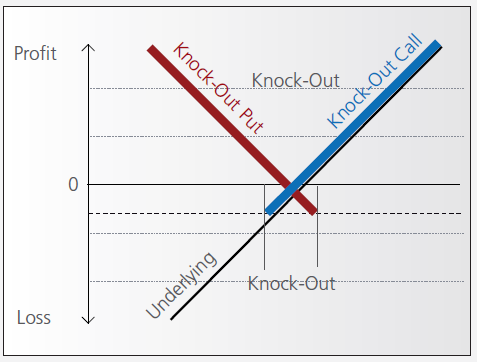
Leverage
As discussed above, knock-out warrants exhibit high degrees of leverage, particularly as the price of the underlying nears the strike/barrier. Consider the following example of a long turbo on the Dow Jones Index, compared to a vanilla warrant:
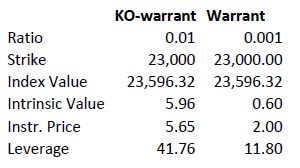
Intrinsic value = (index value – strike) x ratio
Leverage = Index Value x Ratio / Instrument Price
A vanilla warrant retains significant time value even as the underlying price approaches the strike, sharply reducing its leverage compared to a knock-out warrant.
Product types
As discussed above, the barrier may either equal the strike, or be set above (calls) or below (puts). In the latter cases a small residual value remains after knock-out, corresponding to the difference between the barrier (the stop-loss level) and the strike.
Moreover, knock-out products may either have an expiration date or may be open-ended. This makes a difference in the way interest is accounted for. If the contract has an expiration date interest is included in the premium, the amount of which reduces over time and is zero on expiration. This is analogous to a standard vanilla warrant.
in relation to an expiration date. The price of the contract therefore corresponds exactly to its intrinsic value. Interest however must be accounted for. This is done by a daily adjustment of the barrier and strike. The following example shows the daily adjustment for a long open-end turbo on the Dow Jones Index:
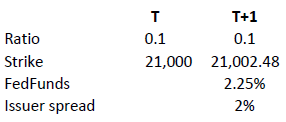
The adjustment = Strike T x (1+ FedFunds/360 + Issuer Spread/360).
The intrinsic value of the instrument is correspondingly reduced as follows, assuming no change in the value of the DJ Index):

Intrinsic value = (index value – strike) x ratio
Discount Certificates Tutorial
Introduction
Discount certificates are designed to provide an enhanced return in sideways markets, compared to a direct investment in the underlying.
Discount certificates make it possible for you to buy an underlying instrument for less than its current market price. However, the maximum payback on a discount certificate is limited to a predetermined amount (cap).
Discount certificates normally have a term to maturity of one to three years. At maturity, a determination is made of where the price of the underlying instrument stands.
If it is at or above the cap, you’ll earn the maximum return and receive payment of the amount reflected by the cap.
If the price of the underlying instrument is below the cap on the maturity date, you’ll receive either the corresponding number of shares or a cash settlement reflecting the value of the underlying instrument on the maturity date.
Pay-out Profile
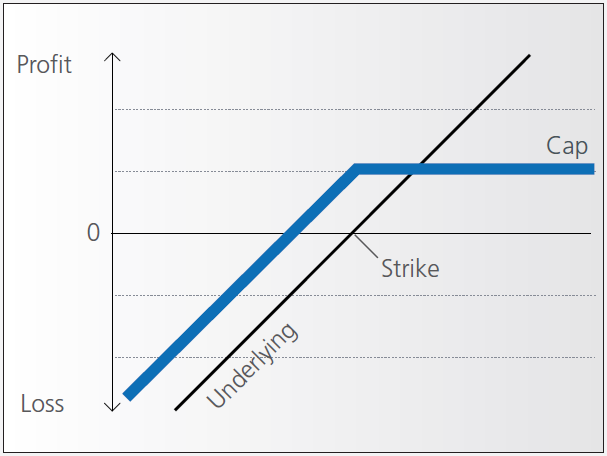
Example
Assume a discount certificate on ABC share. The certificate has a cap of EUR 40.00, and a purchase price of EUR 36.00. The table below shows scenarios depending on the final price of the underlying.
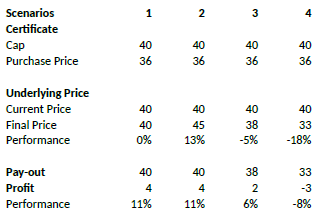
Factor Certificates Tutorial
Introduction
Factor certificates employ a daily leverage factor that multiplies the daily performance of the underlying instrument. Unlike knock-out warrants and mini-futures, factor certificates do not have a knock-out barrier. To avoid a loss greater than the investment, the calculation resets intraday if the performance of the underlying threatens to render the certificate worthless.
Daily Leverage
The performance of the certificate is calculated daily, without reference to previous days’ values. If the underlying returns 1% on the day, the value of 3x certificate increases by 3%, a 5x by 5%. The next day the process is repeated, referencing the prior day’s underlying close.
As such, factor certificates are particularly suitable for day-traders.
However, for a period of more than one day, the cumulative performance of the underlying cannot be simply multiplied by a factor of 3 as the previous day’s price always forms the new basis of calculating each day’s performance for the certificate. To illustrate with an example:

Cumulatively, the factor certificate has returned less than 3x the performance of the underlying.
Intraday Reset
If an underlying for a factor certificate loses more than a certain percentage of its value intraday, the calculation is reset by simulating a new day. The reset threshold varies depending on the leverage factor.
Let’s assume a long factor certificate with a 10x leverage factor. According to the terms of the certificate, a reset will be triggered if the underlying loses more than 9.5% during the calculation day.
Let’s now assume that the underlying loses 12% of its value during a particular day. The reset
and final performance will be as follows:

Что такое SMA и как он устроен?
SMA – это "Специальный гарантийный счет" (Special Memorandum Account), представляющий собой не капитал или наличные средства, а скорее кредитную линию, создаваемую при увеличении рыночной стоимости ценных бумаг маржевого счета Reg. T. Цель такого счета состоит в сохранении покупательской способности, обеспечиваемой нереализованной прибылью, для дальнейших покупок, которая в противном случае может быть гарантирована только путем вывода избытка капитала и последующим внесением его на счет в момент совершения покупки. Таким образом SMA помогает поддерживать постоянный остаток на счете и избегать излишних переводов.
SMA увеличивается вместе с ростом ценной бумаги, однако не уменьшается при падении ее стоимости. Стоимость SMA снижается только при покупке ценных бумаг или выводе наличных средств, и единственное ограничение по его использованию состоит в том, что остаток на нем не должен опускаться ниже минимальных маржинальных требований в результате упомянутых операций. Транзакции, которые способствуют увеличению SMA, включают: денежные депозиты, доход от процентов или дивиденды (в отношении "доллар в доллар") или продажа ценных бумаг (50% чистой прибыли). Обращаем Ваше внимание, что остаток по счету SMA отражает совокупность всех влияющих на него бухгалтерских записей с момента открытия счета. Учитывая типично охватываемый временной период и объем записей, сверка текущего уровня остатка SMA с ежедневными выписками по операциям, хотя и осуществима, представляется нецелесообразной.
Чтобы понять, как работает SMA, представим, что владелец счета вносит $5,000 и покупает $10,000 ценных бумаг с кредитом в размере 50% от стоимости (или маржинальными требованиями, равными 1 – сумма кредита, или 50%). Тогда показатели счета до и после выглядят следующим образом:
|
Строка
|
Описание
|
Событие 1 –
исходный депозит
|
Событие 2 –
покупка акций
|
|
A.
|
Наличные
|
$5,000
|
($5,000)
|
|
B.
|
Рыночная стоимость длинных акций
|
$0
|
$10,000
|
|
C.
|
Чистая ликвидационная стоимость/EWL* (A + B)
|
$5,000
|
$5,000
|
|
D.
|
Начальные маржинальные требования (B * 50%)
|
$0
|
$5,000
|
|
E
|
Доступные средства (C - D)
|
$5,000
|
$0
|
|
F.
|
SMA
|
$5,000
|
$0
|
|
G.
|
Покупательская способность
|
$10,000
|
$0
|
Далее представим, что стоимость длинных акций увеличилась до $12,000. Этот рост рыночной стоимости на $2,000 приведет к созданию счета SMA размером в $1,000, что позволит владельцу счета: 1) дополнительно приобрести ценные бумаги стоимостью в $2,000 без необходимости вкладывать дополнительные средства и выплаты 50%-ой ставки маржи; или 2) вывести $1,000 наличными, которые можно финансировать путем увеличения дебетового остатка, если на счете нет наличных денежных средств. См. ниже:
|
Строка
|
Описание
|
Событие 2 –
покупка акций
|
Событие 3 –
рост акций
|
|
A.
|
Наличные
|
($5,000)
|
($5,000)
|
|
B.
|
Рыночная стоимость длинных акций
|
$10,000
|
$12,000
|
|
C.
|
Чистая ликвидационная стоимость/EWL* (A + B)
|
$5,000
|
$7,000
|
|
D.
|
Начальные маржинальные требования (B * 50%)
|
$5,000
|
$6,000
|
|
E
|
Доступные средства (C - D)
|
$0
|
$1,000
|
|
F.
|
SMA
|
$0
|
$1,000
|
|
G.
|
Покупательская способность
|
$0
|
$2,000
|
*EWL отражает стоимость капитала с кредитом, которая в данном примере равна чистой ликвидационной стоимости.
В заключение, также обратите внимание, что SMA является понятием Reg. T, которое используется для оценки соответствия счетов ценных бумаг, хранящихся в IB LLC, суточным начальным маржинальным требованиям, но не внутридневным или суточным минимальным требованиям. Оно также не используется для определения того, удовлетворяют ли маржинальным требованиям счета биржевых товаров. Аналогичным образом, счета с отрицательным SMA в момент вступления в силу суточных или начальных маржинальных требований Reg.T (15:50 ET) подвергаются ликвидации позиций для восстановления соответствия требованиям маржи.
Complex Position Size
For complex, multi-leg options positions comprising two or more legs, TWS might not track all changes to this position, e.g. a vertical spread where the short leg is assigned and the user re-writes the same leg the next day, or if the user creates a the position over multiple trades, or if the order is not filled as a native combination at the exchange.
Добавление/удаление ликвидности
Цель данной статьи - разъяснить биржевые сборы, а также плату за добавление/удаление ликвидности при раздельных комиссиях.
Принцип добавления или удаления ликвидности применим как к акциям, так и к опционам на акции/индексы. Влияние ордера на ликвидность зависит от того, является ли он реализуемым или нереализуемым.
Реализуемые ордера УСТРАНЯЮТ ликвидность.
Реализуемые ордера - это либо рыночные ордера, либо лимитные ордера на продажу/покупку с предельной ценой на уровне или выше/ниже рыночной.
1. Лимитная цена реализуемого ордера покупки находится на уровне аска или выше него.
2. Предельная цена реализуемого лимитного ордера продажи находится на уровне бида или ниже него.
Пример:
Текущий размер/цена АСКА (предложения) XYZ составляет 400 акций по 46.00. Вы вводите лимитный ордер на покупку 100 акций XYZ по 46.01. Этот ордер будет считаться реализуемым, поскольку он немедленно исполнится. Если на бирже установлен сбор за понижение ликвидности, то клиент должен будет его оплатить.
Нереализуемые ордера являются лимитными ордерами на покупку/продажу с предельной ценой ниже/выше рыночной.
1. Предельная цена нереализуемого лимитного ордера покупки находится ниже аска.
2. Предельная цена нереализуемого лимитного ордера продажи находится выше бида.
Пример:
Текущий размер/цена АСКА (предложения) XYZ составляет 400 акций по 46.00. Вы вводите лимитный ордер на покупку 100 акций XYZ по 45.99. Данный ордер будет считаться нереализуемым, поскольку он разместится на рынке как лучший бид вместо того, чтобы сразу же исполниться.
Если кто-то отправит ордер, на основе которого ваш лимитный ордер покупки исполнится, и если будет доступен бонус за добавление ликвидности, то вы получите рибейт (ретроспективный вычет).
ПРИМЕЧАНИЯ:
1. На все счета, торгующие опционами, распространяются биржевые сборы или бонусы за устранение/добавление ликвидности.
2. Только отрицательные значения в графе устранения/добавления ликвидности на сайте IB являются рибейтами (возвратными бонусами).
https://www.interactivebrokers.com/ru/index.php?f=5492
Почему отличаются комиссии за опционы США?
В комиссии IB за опционы входят две составляющие:
1. Плата за исполнение, причитающаяся IB. Для Smart-маршрутизированных ордеров действует плата в $0.70 за каждый контракт, но она понижается до $0.15, когда сделки начинают превышать 100,000 контрактов за текущий месяц (посетите наш сайт, чтобы узнать стоимость ордеров с прямой маршрутизацией, льготные ставки для опционов с низкой премией и минимальные сборы за ордер); и
2. Сторонние биржевые, регуляторные и/или операционные сборы.
Что касается сторонних сборов, структура некоторых опционных бирж США включает в себя сборы/рибейты за ликвидность, поэтому, в сумме с платой IB за исполнение и прочими регуляторными или операционными издержками, общие комиссии за контракт могут отличаться между ордерами. Это обусловлено с биржевыми расчетами, результатом которых может быть не сбор, а выплата клиенту, и которые зависят от ряда факторов вне контроля IB, включая атрибуты клиентского ордера и преобладающие котировки бида/аска.
Биржи, работающие на основе данной модели сборов/рибейтов за ликвидность, взимают плату за ордера, способствующие снижению ликвидности (т.е. реализуемые рыночные ордера), и предоставляют возвратную скидку за ордера, повышающие ликвидность (т.е. лимитные нерыночные ордера). Сборы могут отличаться в зависимости от биржи, типа клиента (напр., брокер-дилер, фирма, маркет-мейкер, профессионал) и андерлаинга опциона; рибейты (вовзратные выплаты) публичных клиентов, как правило, составляют $0.10 - $0.42, а сборы $0.15 - $0.50.
IB обязаны направлять реализуемые опционные ордера на биржу, предлагающую самую лучшую цену исполнения. При наличии нескольких вариантов Smart-маршрутизатор выбирает место назначения ордера, опираясь на плату за устранение ликвидности (т.е. ордер будет направлен на биржу с наименьшей или отсутствующей платой). Соответственно, Smart-маршрутизатор направит рыночный ордер на биржу с более высоким сбором, только если это обеспечит выигрыш в цене хотя бы на $0.01 (что, с учетом стандартного множителя опциона 100, приведет к улучшению цены в $1.00, которое превосходит самую высокую плату за устранение ликвидности).
Дополнительная информация о добавлении/устранении ликвидности, включая примеры, доступна в статье KB201.
Risks of Volatility Products
Trading and investing in volatility-related Exchange-Traded Products (ETPs) is not appropriate for all investors and presents different risks than other types of products. Among other things, ETPs are subject to the risks you may face if investing in the components of the ETP, including the risks relating to investing in complex securities (such as futures and swaps) and risks associated with the effects of leveraged investing in geared funds. Investors should be familiar with the diverse characteristics of each ETF, ETN, future, option, swap and any other relevant security type. We have summarized several risk factors (as identified in prospectuses for ETPs and in other sources) and included links so you can conduct further research. Please keep in mind that this is not a complete list of the risks associated with these products and investors are responsible for understanding and familiarizing themselves completely before entering into risk-taking activities. By providing this information, Interactive Brokers (IB) is not offering investment or trading advice regarding ETPs to any customer. Customers (and/or their independent financial advisors) must decide for themselves whether ETPs are an appropriate investment for their portfolios.
Приоритет ордеров профессиональных клиентов
В 4-ом квартале 2009 года определенные американские биржи опционов (CBOE, ISE) ввели правила, различающие ордера публичных клиентов со статусом "Профессионал" (т.е. лиц с доступом к данным и/или технологиям, которые в некоторой мере позволяют им торговать как брокер-дилер) и розничные ордера. Согласно этим правилам, если клиент не является брокером-дилером и в среднем ежедневно размещает более 390 опционных ордеров (независимо от того, исполняются они или нет) в течение месяца, он будет классифицирован как "Профессионал". После первичной интеграции на CBOE и ISE похожие правила для определения "профессиональных" ордеров были введены и большинством других опционных бирж США.
Уровень важности исполнения ордеров, размещенных на данных биржах от имени профессиональных клиентов, будет соответствовать ордерам брокеров-дилеров. На них также будет налагаться плата за контракт, которая может колебаться от рибейтов в $0,65 до сборов в $1,12 (в зависимости от класса опционов).
Брокеры обязаны производить ежеквартальную проверку для выявления клиентов, которые превысили порог в 390 ордеров за любой месяц рассматриваемого периода и которым в следующем квартале будет присвоен статус "Профессионал". Обращаем внимание, что в рамках данного правила спред-ордера рассматриваются как один ордер, т.е. леги не считаются отдельными сделками. Клиенты, подпадающие под действие этого предписания, будут уведомлены IB. Вдобавок, принимая решение, куда направить ордер, Smart-маршрутизатор IB будет учитывать эти новые биржевые сборы.
Дополнительную информацию можно найти по следующим ссылкам:
